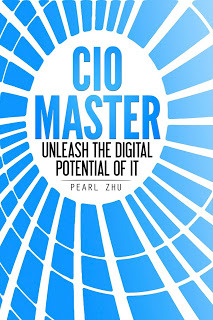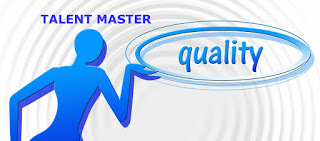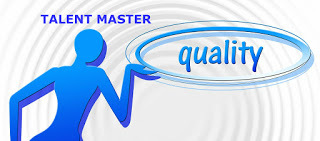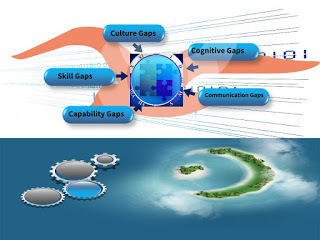Pearl Zhu's Blog, page 1352
April 1, 2016
The Weekly Insight of the “Future of CIO”: The New Book "CIO Master" Preview (Part I) 3/31/2016
The New Book Proview “CIO Master - Unleash the Digital Potential of IT" (Part I)
 The purpose of CIO Master - Unleash the Digital Potential of IT (Total Nine Chapters) is to provide guidelines for building a framework to run a highly effective, highly innovative and highly mature digital IT organization. Also, it provides the principles to reinvent CIO leadership via practicing multitudes of digital influence.
The purpose of CIO Master - Unleash the Digital Potential of IT (Total Nine Chapters) is to provide guidelines for building a framework to run a highly effective, highly innovative and highly mature digital IT organization. Also, it provides the principles to reinvent CIO leadership via practicing multitudes of digital influence.
“ CIO Master” Book Preview, Slideshare, Video:-Rebrand digital CIOs with multiple personas -Reinvent IT to unleash its full digital potential-Reenergize changes as an ongoing digital capability-Refine talent management to bridge IT skills gap-Remaster multidimensional IT to create multi-level business value-Renovate strategy execution continuum to improve effectiveness-Reimagine IT as an innovation engine to catalyze business growth -Reshape IT via leveraging “3P”s: Principle, Portfolio, Performance-Retool IT agility to adapt to changes
“CIO Master” Book Preview: Chapter 1 “Twelve Digital CIO Personas” Introduction Nowadays, information is lifeblood, and technology is the disruptive force in any business and any industry. Hence, CIOs as IT leaders play a more critical role in business strategy making & execution, digital transformation, driving business changes and innovation. Compared to other CxO positions, the CIO role is considerably new with less than three decades of history, but more dynamic and paradoxical. The IT leadership role also continues to be reimagined, refined, refreshed, and reenergized. The CIO is no longer just a glorified geek, but a business savvy strategist and transformational business leader. Modern CIOs have multiple personas and need to wear many hats to communicate effectively and lead more successfully. In chapter 1 of “CIO Master - Unleash the Digital Potential of IT,” we describe CIOs’ 12 Digital profiles. Here we list five featured CIO personas:
“CIO Master” Book Preview: Chapter 2 “CIOs as Digital Visionary” Introduction The Digital Era makes a significant impact on every aspect of the business from people to process, to technology, both horizontally and vertically. In many forward-looking organizations, IT plays a pivotal role in such a radical transformation. The CIO also becomes a strategic leadership role in conveying the digital vision and co-create business strategy and reinventing IT as a growth and innovation engine of the organization. More specifically, visionary CIOs play the following unique role.
“CIO Master” Book Preview: Chapter 3 “CIOs as Change Agent” Introduction Change is inevitable. And the speed of change is accelerating. Often information abundance catalyzes change, and technology is the disruptive force behind changes. Hence, CIOs shouldn’t get pushed for the changes, they are actually in a better position to play a role as change agent. Many forward-looking organizations empower their CIOs as forerunners to drive changes and lead digital transformation at the organizational level. CIOs as Change Agents: How to lead change effectively?
 “CIO Master” Book Preview: Chapter 4 CIO as Talent Master Introduction People are always the most invaluable asset in any business. “Hiring the right person with the right capability for the right position at the right time,” is the mantra for any forward-looking organization at the Digital Era. The point is how would you define the right people, how do you define wrong, average, mediocre, good, great or extraordinary person? It IT skills gap fact or fiction? Shall you hire character, mindset, or skills? What’s the best way to build a solid digital pipeline for discovering authentic and high potential leaders and digital professionals for the business growth?
“CIO Master” Book Preview: Chapter 4 CIO as Talent Master Introduction People are always the most invaluable asset in any business. “Hiring the right person with the right capability for the right position at the right time,” is the mantra for any forward-looking organization at the Digital Era. The point is how would you define the right people, how do you define wrong, average, mediocre, good, great or extraordinary person? It IT skills gap fact or fiction? Shall you hire character, mindset, or skills? What’s the best way to build a solid digital pipeline for discovering authentic and high potential leaders and digital professionals for the business growth?
"CIO Master” Book Preview: Chapter 5 Thirteen Digital Flavored IT In today's digital business environment, information is the lifeblood, and technology touches every phase and each corner of the business, IT running in an industrial mode as a business controller or cost center no longer fits in the fast changing business circumstances or volatile digital dynamic, how to run IT with the growth mentality at digital speed? How to run IT as an innovation engine and a digital forerunner, And from IT management perspective, we introduce 13 “digital-flavored IT” to accelerate digital transformation in this chapter. Here we briefly describe five featured digital IT. CIO Master Order Link CIO Master Order Link on AmazonCIO Master Ordre Link on Barner & NobleCIO Master Order Link On IBooks
CIO Master Introduction Link: "CIO Master” Book Preview: Chapter 5 Thirteen Digital Flavored IT“CIO Master” Book Preview: Chapter 4 CIO as Talent Master Introduction“CIO Master” Book Preview: Chapter 3 “CIOs as Change Agent” Introduction“CIO Master” Book Preview: Chapter 2 “CIOs as Digital Visionary” Introduction“CIO Master” Book Preview: Chapter 1 “Twelve Digital CIO Personas” Introduction"CIO Master - Unleash the Digital Potential of IT" Introduction
"CIO Master - Unleash the Digital Potential of IT" Book Preview
Follow us at: @Pearl_Zhu
 The purpose of CIO Master - Unleash the Digital Potential of IT (Total Nine Chapters) is to provide guidelines for building a framework to run a highly effective, highly innovative and highly mature digital IT organization. Also, it provides the principles to reinvent CIO leadership via practicing multitudes of digital influence.
The purpose of CIO Master - Unleash the Digital Potential of IT (Total Nine Chapters) is to provide guidelines for building a framework to run a highly effective, highly innovative and highly mature digital IT organization. Also, it provides the principles to reinvent CIO leadership via practicing multitudes of digital influence. “ CIO Master” Book Preview, Slideshare, Video:-Rebrand digital CIOs with multiple personas -Reinvent IT to unleash its full digital potential-Reenergize changes as an ongoing digital capability-Refine talent management to bridge IT skills gap-Remaster multidimensional IT to create multi-level business value-Renovate strategy execution continuum to improve effectiveness-Reimagine IT as an innovation engine to catalyze business growth -Reshape IT via leveraging “3P”s: Principle, Portfolio, Performance-Retool IT agility to adapt to changes
“CIO Master” Book Preview: Chapter 1 “Twelve Digital CIO Personas” Introduction Nowadays, information is lifeblood, and technology is the disruptive force in any business and any industry. Hence, CIOs as IT leaders play a more critical role in business strategy making & execution, digital transformation, driving business changes and innovation. Compared to other CxO positions, the CIO role is considerably new with less than three decades of history, but more dynamic and paradoxical. The IT leadership role also continues to be reimagined, refined, refreshed, and reenergized. The CIO is no longer just a glorified geek, but a business savvy strategist and transformational business leader. Modern CIOs have multiple personas and need to wear many hats to communicate effectively and lead more successfully. In chapter 1 of “CIO Master - Unleash the Digital Potential of IT,” we describe CIOs’ 12 Digital profiles. Here we list five featured CIO personas:
“CIO Master” Book Preview: Chapter 2 “CIOs as Digital Visionary” Introduction The Digital Era makes a significant impact on every aspect of the business from people to process, to technology, both horizontally and vertically. In many forward-looking organizations, IT plays a pivotal role in such a radical transformation. The CIO also becomes a strategic leadership role in conveying the digital vision and co-create business strategy and reinventing IT as a growth and innovation engine of the organization. More specifically, visionary CIOs play the following unique role.
“CIO Master” Book Preview: Chapter 3 “CIOs as Change Agent” Introduction Change is inevitable. And the speed of change is accelerating. Often information abundance catalyzes change, and technology is the disruptive force behind changes. Hence, CIOs shouldn’t get pushed for the changes, they are actually in a better position to play a role as change agent. Many forward-looking organizations empower their CIOs as forerunners to drive changes and lead digital transformation at the organizational level. CIOs as Change Agents: How to lead change effectively?
 “CIO Master” Book Preview: Chapter 4 CIO as Talent Master Introduction People are always the most invaluable asset in any business. “Hiring the right person with the right capability for the right position at the right time,” is the mantra for any forward-looking organization at the Digital Era. The point is how would you define the right people, how do you define wrong, average, mediocre, good, great or extraordinary person? It IT skills gap fact or fiction? Shall you hire character, mindset, or skills? What’s the best way to build a solid digital pipeline for discovering authentic and high potential leaders and digital professionals for the business growth?
“CIO Master” Book Preview: Chapter 4 CIO as Talent Master Introduction People are always the most invaluable asset in any business. “Hiring the right person with the right capability for the right position at the right time,” is the mantra for any forward-looking organization at the Digital Era. The point is how would you define the right people, how do you define wrong, average, mediocre, good, great or extraordinary person? It IT skills gap fact or fiction? Shall you hire character, mindset, or skills? What’s the best way to build a solid digital pipeline for discovering authentic and high potential leaders and digital professionals for the business growth?
"CIO Master” Book Preview: Chapter 5 Thirteen Digital Flavored IT In today's digital business environment, information is the lifeblood, and technology touches every phase and each corner of the business, IT running in an industrial mode as a business controller or cost center no longer fits in the fast changing business circumstances or volatile digital dynamic, how to run IT with the growth mentality at digital speed? How to run IT as an innovation engine and a digital forerunner, And from IT management perspective, we introduce 13 “digital-flavored IT” to accelerate digital transformation in this chapter. Here we briefly describe five featured digital IT. CIO Master Order Link CIO Master Order Link on AmazonCIO Master Ordre Link on Barner & NobleCIO Master Order Link On IBooks
CIO Master Introduction Link: "CIO Master” Book Preview: Chapter 5 Thirteen Digital Flavored IT“CIO Master” Book Preview: Chapter 4 CIO as Talent Master Introduction“CIO Master” Book Preview: Chapter 3 “CIOs as Change Agent” Introduction“CIO Master” Book Preview: Chapter 2 “CIOs as Digital Visionary” Introduction“CIO Master” Book Preview: Chapter 1 “Twelve Digital CIO Personas” Introduction"CIO Master - Unleash the Digital Potential of IT" Introduction
"CIO Master - Unleash the Digital Potential of IT" Book Preview
Follow us at: @Pearl_Zhu
Published on April 01, 2016 15:32
March 31, 2016
IT Agility Sum Up: Agile Dot Connection
 Agility within and of itself is a strategy. Agility is not only the ability to create the change, but also the capability to adapt to the changes. Within an IT, organizational agility should be defined as the speed in which the organization can enable the enterprise's goals and objectives as IT strategy is an integral element of business strategy. Agile is a culture as well!It is important to recognize that moving to Agile may require a significant culture change that affects the entire business. It certainly is NOT just a "development thing.”Agile Dot ConnectionAgility vs. Flexibility: Agility is the ability of a business to adapt rapidly and cost efficiently in response to changes in the business environment. Agile provides greater flexibility and it requires great discipline especially at team member level. Great power comes with great reasonability.
Agility within and of itself is a strategy. Agility is not only the ability to create the change, but also the capability to adapt to the changes. Within an IT, organizational agility should be defined as the speed in which the organization can enable the enterprise's goals and objectives as IT strategy is an integral element of business strategy. Agile is a culture as well!It is important to recognize that moving to Agile may require a significant culture change that affects the entire business. It certainly is NOT just a "development thing.”Agile Dot ConnectionAgility vs. Flexibility: Agility is the ability of a business to adapt rapidly and cost efficiently in response to changes in the business environment. Agile provides greater flexibility and it requires great discipline especially at team member level. Great power comes with great reasonability.
Agility vs. Accountability -Agile has emerged as a major methodology and a set of practices for many IT organizations for software development, it is the time that Agile also needs a serious readjustment to scale it up to a new level. Agile has to be readjusted at different organization levels. Today it is not only about doing Agile, but it is also required outside the software development where accountability really matters, and being Agile - to shape an agile mindset. Agility vs. accountability - what’s the correlation between them?
Agility vs. Quality: (Part II) Agile has emerged as a major software development and management methodology, it is a set of principles, philosophy, and mindsets to either build software or run a business today. However, from the quality perspective, Agile is one of those things that's simple in principle but may be very challenging in practice. How can you maintain quality whilst trying to become agiler?
Agile vs. DevOps: Agile is a big umbrella term refers to the mindset, philosophy and the set of principles to run business or manage projects, also covering the comprehensive methodologies like XP, and lightweight management frameworks like Scrum. DevOps is a deployment pipeline that stresses communication, collaboration and integration between software developers and information Technology (IT) professionals.
 Agile Principles vs. Rules: Leadership is about "why," to discover the underlying leadership or business fundamental principles. Management is about "what", to define the rules based on the set of principles. More specifically, what are the difference and correlation between principles and rules, at today’s Agile working environment or beyond?
Agile Principles vs. Rules: Leadership is about "why," to discover the underlying leadership or business fundamental principles. Management is about "what", to define the rules based on the set of principles. More specifically, what are the difference and correlation between principles and rules, at today’s Agile working environment or beyond?The “Future of CIO” Blog has reached 1.3 million pageviews with about about 2600+ blog posting in 59+ different categories of leadership, management, strategy, digitalization, change/talent, etc. The content richness is not for its own sake, but to convey the vision and share the wisdom. Blogging is not about writing, but about thinking; it’s not just about WHAT to say, but about WHY to say, and HOW to say it. It reflects the color and shade of your thought patterns, and it indicates the peaks and curves of your thinking waves. Unlike pure entertainment, quality and professional content takes time for digesting, contemplation and engaging, and therefore, it takes time to attract the "hungry minds" and the "deep souls." It’s the journey to amplify your voice, deepen your digital footprints, and match your way for human progression.Follow us at: @Pearl_Zhu
Published on March 31, 2016 23:27
"CIO Master” Book Preview: Chapter 5 Thirteen Digital Flavored IT
 In today's digital business environment, information is the lifeblood, and technology touches every phase and each corner of the business, IT running in an industrial mode as a business controller or cost center no longer fits in the fast changing business circumstances or volatile digital dynamic, how to run IT with the growth mentality at digital speed? How to run IT as an innovation engine and a digital forerunner, And from IT management perspective, we introduce 13 “digital-flavored IT” to accelerate digital transformation in this chapter. Here we briefly describe five featured digital IT:
In today's digital business environment, information is the lifeblood, and technology touches every phase and each corner of the business, IT running in an industrial mode as a business controller or cost center no longer fits in the fast changing business circumstances or volatile digital dynamic, how to run IT with the growth mentality at digital speed? How to run IT as an innovation engine and a digital forerunner, And from IT management perspective, we introduce 13 “digital-flavored IT” to accelerate digital transformation in this chapter. Here we briefly describe five featured digital IT:
An Innovative IT: IT is business. Innovative IT can only happen if IT is regarded as a strategic partner and given the role in catalyzing innovation and driving business changes. It’s been the case for a while that IT departments are wrapped in the heroics of bringing systems back online efficiently when really the resources should have been further up to ensure IT can do more with innovation, besides getting the fundamental “Keeping the Light on” right. One of the most appropriate titles of the CIO is “Chief Innovation Officer.” CIOs generally have a greater opportunity to stand out and take a lead in driving innovation across their company scope. IT has a natural innovative spirit. Most IT specialists are eager to use new technologies and gadgets. But there is a significant differences between technical proficiency and business innovation. Natural IT innovation spirit can be used to the benefit of business only when IT participates in defining strategy and business goals and make IT as a business driver, and reinvent IT as an innovation engine. So IT can devote more attention to what organizations really care about - putting technology business advantage.
An Influential IT: Fundamentally, the purpose of IT organization is to ensure the right information going to the right people at the right time and location in order to make the right decision. Hence, IT is an influencer of the business decision-making process, where technology is a key contributor to business success. The big problem of making the right decision is to define a problem. Decision-making scenario is depending on problem context. An effective way for resource allocation and utilization is an important factor for problem framing and decision making. IT could be very useful in terms of looking at things differently, contributing ideas, close functional silos, and offering new methodology, analytics tools, and capabilities to build a high-intelligent digital organization. Hence, IT should be viewed as a stakeholder in the business decision-making process, and make the full fledged influence both through strategic perspective as well as operational lenses.
An Agile IT: Agile is not just a hot IT buzzword, it’s the digital mentality to run today’s businesses, and a set of principles, practices to help businesses drive change and adapt to change promptly. In the context of IT, from the highest strategic to the deepest technical levels, “agility’ is a fast, sure response to external stimuli. It requires distinct patterns of IT capabilities, with specific positioning in the organization. It includes but not limited to portfolio management, project management, change management, rapid adoption and deployment of emergent digital technologies, etc. It takes strategic guideline and follow agile principles, and the purpose of building an Agile IT is to pursue an optimal way in running IT, and improving overall business agility.
A Balanced IT: Modern IT is both complex and paradoxical, because IT has to strike the right balance between innovation and standardization; stability and agility, digital speed and industrial mode, “on-premise” and “on demand” IT applications. The pervasive digitalization or IT consumerism requires the balance of the “old experience” and the new way to do things, the “learning and doing.” Now, we have more computing power, greater connectivity, more data, greater potential empowerment of the digital workers. IT-business alignment is also moving into IT enablement and engagement. To be more effective and successful, IT leaders must support the existing environment, provide reliable service and solutions to achieve operational excellence, but also running in a faster speed while generating initiatives that are leveraging SMAC technologies to “do more with innovation.”
 A Digital Fit IT: We live in the digital age with explosive information and the abundance of knowledge. However, more is not always equal to better. Some commented this is also the era of information overload and “data obesity.” IT organizations are at the center of such changes, suffer from redundant application maintenance and heavy legacy technologies. Complicating technology and processes stifle the business’s change capability and make IT not nimble enough to capture the new digital trend and ride above the change curves. Hence, IT needs to prune the “weed” regularly. The approach is to implement a program that like a gardener prune the tree and nurture the valuable solution. An effective CIO has to continually review existing applications and systems in the light of business set technology directions. Because “keeping IT fit” takes both strategy and discipline, but it’s worth the effort. And it is a significant step in transforming IT from a cost center to an value creator, and elevate IT agility.
A Digital Fit IT: We live in the digital age with explosive information and the abundance of knowledge. However, more is not always equal to better. Some commented this is also the era of information overload and “data obesity.” IT organizations are at the center of such changes, suffer from redundant application maintenance and heavy legacy technologies. Complicating technology and processes stifle the business’s change capability and make IT not nimble enough to capture the new digital trend and ride above the change curves. Hence, IT needs to prune the “weed” regularly. The approach is to implement a program that like a gardener prune the tree and nurture the valuable solution. An effective CIO has to continually review existing applications and systems in the light of business set technology directions. Because “keeping IT fit” takes both strategy and discipline, but it’s worth the effort. And it is a significant step in transforming IT from a cost center to an value creator, and elevate IT agility.
Run, Grow, and Transform! You can choose your own favorite ‘digital flavor’ to run an highly effective IT organization to strengthen the strength or strengthen the weakness. But you need to run well a balanced portfolio to both ‘keep the light on’ and drive digital transformation journey. And it takes very solid leadership, focus, and the ability to build strong relationships with all levels of the organization, IT has to become a business enabler to catalyze the change and improve organizational effectiveness and agility.
“CIO Master” Book Preview: Chapter 4 CIO as Talent Master Introduction“CIO Master” Book Preview: Chapter 3 “CIOs as Change Agent” Introduction“CIO Master” Book Preview: Chapter 2 “CIOs as Digital Visionary” Introduction“CIO Master” Book Preview: Chapter 1 “Twelve Digital CIO Personas” Introduction"CIO Master - Unleash the Digital Potential of IT" Introduction"CIO Master - Unleash the Digital Potential of IT" Book Preview
CIO Master Order Link on AmazonCIO Master Ordre Link on Barner & NobleCIO Master Order LinkOn IBooks
Follow us at: @Pearl_Zhu
Published on March 31, 2016 23:24
Three Questions to Assess a Person’s Self-Awareness
 Self-awareness has generally been viewed as an individual attribute, it’s the introspect and ability to understand your own personality, emotion, thought processes, habit., etc. Knowing who you are and how you react and respond in different situations can help you understand and improve the cognitive, relational and assertive actions you take on a day to day basis. It could also help you to make either career or life as an adventurous journey to discover the path you take and unleash the talent potential. Which questions should ask to assess a person’s self-awareness ability?
Self-awareness has generally been viewed as an individual attribute, it’s the introspect and ability to understand your own personality, emotion, thought processes, habit., etc. Knowing who you are and how you react and respond in different situations can help you understand and improve the cognitive, relational and assertive actions you take on a day to day basis. It could also help you to make either career or life as an adventurous journey to discover the path you take and unleash the talent potential. Which questions should ask to assess a person’s self-awareness ability?
How deep do you understand yourself, before you get to understand others? To create a positive change tomorrow, someone needs to start today understanding self. Not knowing ourselves as best as you can, how can you do any change and aim for a positive change? So investigate more and more yourself every day, and be authentic. Self-awareness mind helps you build on your strengths and improve on your weaknesses. It also allows you to leverage that knowledge to increase the influential outreach for the betterment of others. It provides clarity, versatility, gives you directional opportunities for personal growth and helps you avoid pitfalls. It is crucial to getting to understand yourself and how others perceive you. Additional, carve out time with some regular cadence to reflect on what, and how, you have been doing lately. Set aside time daily, weekly or monthly and truly take a step back to reflect.
Do you continuously practice on harmonize your mind, body, emotion and energy to focus on things matters to you? The mind is the output as ideas, opinions, feelings, emotions, attitude, attributes of one’s behaviors. You are just these four things; body, mind, emotion and energy. Right now, the combination of these four is what you call “self.” Ask yourself questions that focus on know thyself and continuously practice on how to strengthen your strength, also not make your weakness become the obstacle to stop you from moving forward or leading effectiveness. This has helped you in understanding how you can do a change on self, that will positively reflect anyone around you. In this way, the result is not only positive for you and for people next to you, but it lasts longer both for you and those you can influence
 From talent management perspective, do you have an authentic business culture to let people become “who they really are”? Highly authentic digital cultures don't reflect their members, their members reflect them; meaning you select team members who are natural fits, or “misfit” to have the fresh eyes and creative mind to innovate working environment. It is a culture that encourages real thinking and being authentic, one that is comfortable with uncertainty. Culture is determined by behaviors - how do you act/react to everything at all times. It is a reflection of the mindset. Successful culture change helps people become who they are. By encouraging people to focus on who they are, and pursue the purpose discovery, autonomy, and mastery, the great culture catalyzes positive mind, attitude, and behaviors; but discourage negativity and unprofessionalism.
From talent management perspective, do you have an authentic business culture to let people become “who they really are”? Highly authentic digital cultures don't reflect their members, their members reflect them; meaning you select team members who are natural fits, or “misfit” to have the fresh eyes and creative mind to innovate working environment. It is a culture that encourages real thinking and being authentic, one that is comfortable with uncertainty. Culture is determined by behaviors - how do you act/react to everything at all times. It is a reflection of the mindset. Successful culture change helps people become who they are. By encouraging people to focus on who they are, and pursue the purpose discovery, autonomy, and mastery, the great culture catalyzes positive mind, attitude, and behaviors; but discourage negativity and unprofessionalism.
A self-awareness mind continues to practice reflective thinking: Better understand yourselves and how knowing who you are and your own style of influence affect how you respond and interact with not only your team but also your surroundings. Knowing oneself comes from the practice of actively and intentionally being present to relate to, see all the different parts of oneself and how they operate, to set the priority and manage time doing things matters to you more effectively.
Follow us at: @Pearl_Zhu
Published on March 31, 2016 23:19
March 30, 2016
IT Agility Sum Up: Agile Pitfalls
 Agility within and of itself is a strategy. Agility is not only the ability to create the change, but also the capability to adapt to the changes. Within an IT, organizational agility should be defined as the speed in which the organization can enable the enterprise's goals and objectives as IT strategy is an integral element of business strategy. Agile is a culture as well!It is important to recognize that moving to Agile may require a significant culture change that affects the entire business. It certainly is NOT just a "development thing.”Agile PitfallsWhy is being Agile so Hard? Agile becomes mainstream software management philosophy and methodology, however, most of the organizations are at the stage of doing Agile, not being agile, doing agile is a set of activities; but being agile is the state of mind, the ongoing capability, and the culture adaptability. To dig through, why is being agile so hard?
Agility within and of itself is a strategy. Agility is not only the ability to create the change, but also the capability to adapt to the changes. Within an IT, organizational agility should be defined as the speed in which the organization can enable the enterprise's goals and objectives as IT strategy is an integral element of business strategy. Agile is a culture as well!It is important to recognize that moving to Agile may require a significant culture change that affects the entire business. It certainly is NOT just a "development thing.”Agile PitfallsWhy is being Agile so Hard? Agile becomes mainstream software management philosophy and methodology, however, most of the organizations are at the stage of doing Agile, not being agile, doing agile is a set of activities; but being agile is the state of mind, the ongoing capability, and the culture adaptability. To dig through, why is being agile so hard?
The Pitfalls in Agile movement Agile is emerged as a philosophy to run today’s digital organizations with a set of principles to refine business management and culture. However, it is a thorny journey, What are the biggest problems for people or companies when they decide to go Agile - not just doing Agile, but being agile? What is the hardest thing when you choose that road? What are your biggest pains? And what are the pitfalls to fail you, and how can you learn from your mistakes to make a continuous improvement?
How to Overcome the Obstacles of Agile Transformation? More and more organizations are on their journey from doing Agile to being agile, and there are many obstacles on the way, what are the causes of those failures, do they fail to follow the principles, or are they failing to do the best practices? Are they failing forward or backward? Who should take more responsibility -the leadership or fellowship?
Agile’s RoadBlocks: Agile becomes the mainstream software management methodology, even turns to be the corporate management philosophy, however, going Agile is not an easy journey, what are the biggest problems for people or companies when they decide to go Agile.What is the hardest thing when you choose that road? What are your biggest pains?
 Agile Pitfalls: The business purposes of taking Agile methodology is to adapt to change, improve customer satisfaction, and enforce communication. Agile is basically dialogue applied to application development - an iterative process of "thinking together." However, if the people involved have limited skills for thinking together, then agile won't work well at all, as an emergent methodology, Agile causes certain confusions or even failures, what are the potential Agile pitfalls?
Agile Pitfalls: The business purposes of taking Agile methodology is to adapt to change, improve customer satisfaction, and enforce communication. Agile is basically dialogue applied to application development - an iterative process of "thinking together." However, if the people involved have limited skills for thinking together, then agile won't work well at all, as an emergent methodology, Agile causes certain confusions or even failures, what are the potential Agile pitfalls?
The Big Roadblocks for Agile Adoption Though Agile has been adopted by mainstream and has been proven with advantage for iterative communication, incremental improvement and faster delivery, still, there are many roadblocks on the way, what are those top problems when you adopt Agile?
Blogging is not about writing, but about thinking; it’s not just about WHAT to say, but about WHY to say, and HOW to say it. It reflects the color and shade of your thought patterns, and it indicates the peaks and curves of your thinking waves. Unlike pure entertainment, quality and professional content takes time for digesting, contemplation and engaging, and therefore, it takes time to attract the "hungry minds" and the "deep souls." It’s the journey to amplify your voice, deepen your digital footprints, and match your way for human progression.Follow us at: @Pearl_Zhu
Published on March 30, 2016 22:34
“CIO Master” Book Preview: Chapter 4 CIO as Talent Master Introduction
 People are always the most invaluable asset in any business. “Hiring the right person with the right capability for the right position at the right time,” is the mantra for any forward-looking organization. The point is how would you define the right people, how do you define wrong, average, mediocre, good, great or extraordinary person? It IT skills gap fact or fiction? Shall you hire character, mindset, or skills? What’s the best way to build a solid digital pipeline for discovering authentic and high potential leaders and digital professionals for the business growth?
People are always the most invaluable asset in any business. “Hiring the right person with the right capability for the right position at the right time,” is the mantra for any forward-looking organization. The point is how would you define the right people, how do you define wrong, average, mediocre, good, great or extraordinary person? It IT skills gap fact or fiction? Shall you hire character, mindset, or skills? What’s the best way to build a solid digital pipeline for discovering authentic and high potential leaders and digital professionals for the business growth?
Discover the right talent at mindset level: It’s important to find the right people through what they think and how they act. The right mindset is utmost quality for being a right fit because the power of the mind is the force to change for the better business and the world. And then, you could look at the behavior that you expect to see. The “positive energy” the employees bring to the workplace can catalyze the culture of innovation and translate into positive actions as well. When it comes to finding the right people, one must first assume the goal is to find the right person who not only fulfills the required needs of the job at the moment, but also has the potential to lead organizations to the next level. The right person who can not just fit in, but also rejuvenate the organizational culture to accelerate business execution.
 Close IT skills gaps: There’s always a debate regarding IT talent supply and demand, does IT skills gap really exist? Are they “skill gaps,” or simply “misunderstanding” or “miscommunication” gaps? And how to not just fix the symptoms, but dig through the root cause and build the long term talent management strategy and develop a set of best and next practices for talent management innovation? IT is transforming to reach high level of maturity, it should take a preponderant importance in the coming years to make sustainable IT-Business relationship. IT talent needs to have both technical and business skills, the high quality IT professionals are those who can work independently, have excellent problem-solving skills, well-disciplined, have a “customer focus,” and communicate well. It’s also important to hire really bright energetic and positive people who may have less specific skills, but have the traits described as intelligence, problem-solving, creativity learning agility, communication skills, etc.
Close IT skills gaps: There’s always a debate regarding IT talent supply and demand, does IT skills gap really exist? Are they “skill gaps,” or simply “misunderstanding” or “miscommunication” gaps? And how to not just fix the symptoms, but dig through the root cause and build the long term talent management strategy and develop a set of best and next practices for talent management innovation? IT is transforming to reach high level of maturity, it should take a preponderant importance in the coming years to make sustainable IT-Business relationship. IT talent needs to have both technical and business skills, the high quality IT professionals are those who can work independently, have excellent problem-solving skills, well-disciplined, have a “customer focus,” and communicate well. It’s also important to hire really bright energetic and positive people who may have less specific skills, but have the traits described as intelligence, problem-solving, creativity learning agility, communication skills, etc.
Data-driven Talent Management: Information is permeating every corner of the business today, especially in talent management space, rather than following traditional subjective HR model, forward-looking organizations should experiment, develop and mature data-driven talent management for leapfrogging digital transformation. More specifically, data-driven talent management will bring business leaders together across the organization to share their insight wherever there is a gap in the system, streamline and identify root cause, and give practical guideline for improving talent management, engaging workforce planning, deployment, and talent development, forecast talent demand, and embrace futuristic trends such as visualization and proactive presentation., etc. Though it’s challenging, but integrating data-driven tools into talent management will elevate the organization to be more fact-based, more objective and cost-effective.
Bridging so many gaps in IT talent management is obviously not an overnight job, and it takes a thought-out planning and practices. Whether IT can attract the brightest talent or not also depends on how effective the CIO is marketing his/her organization. And the best way to attract talent is to offer excellence in everything you do such as the workplace, training, communication, positive culture, and the most important thing is insightful talent management.
“CIO Master” Book Preview: Chapter 3 “CIOs as Change Agent” Introduction“CIO Master” Book Preview: Chapter 2 “CIOs as Digital Visionary” Introduction“CIO Master” Book Preview: Chapter 1 “Twelve Digital CIO Personas” Introduction"CIO Master - Unleash the Digital Potential of IT" Introduction"CIO Master - Unleash the Digital Potential of IT" Book Preview
CIO Master Order Link on AmazonCIO Master Ordre Link on Barner & Noble
CIO Master Order LinkOn IBooks
Follow us at: @Pearl_Zhu
Published on March 30, 2016 22:29
March 29, 2016
Three Stages to Reach Digital Maturity
 Going Digital is no brainer. However, reaching the high level of digital maturity is a thorny journey. Organizations need to make continuous check-up: Are you achieving the desired outcomes? Are you transforming to be ready for the future? Are you shaping the good digital strategy about the future and positioning appropriately for your place within it? Do you have enough resource to implement the digital strategy? Are the assumptions and risks understood and manageable?What are critical stages the organizations need to take in order to build a high-mature digital organization?
Going Digital is no brainer. However, reaching the high level of digital maturity is a thorny journey. Organizations need to make continuous check-up: Are you achieving the desired outcomes? Are you transforming to be ready for the future? Are you shaping the good digital strategy about the future and positioning appropriately for your place within it? Do you have enough resource to implement the digital strategy? Are the assumptions and risks understood and manageable?What are critical stages the organizations need to take in order to build a high-mature digital organization?
Digital awareness: Organizations have personalities in the same way that an individual does. More often, an organization's personality replicates the personality of its leader. In organizations that tend to "shoot from the hip," there is a lack of strategic and tactical plans for problem-solving, or the plan is written on high and passed down in stone without employee participation. There are a number of challenges common in transformation programs, such as getting the right strategies, execution, a good leader to drive the transformational vision, and broader view of consumer demand, etc. They come up over and, those are the reasons why approximately 80% of these programs fail. Many of them are symptomatic of not having a comprehensive and strategic approach to transformation. Almost all organizations 'want' to change, they just don't have the roadmap. To become digital awareness, organizations need to have a comprehensive digital strategy with the first step to understanding business problems and gain the full awareness of both potentials and perils. The toughest part of the strategy is the trade-offs: The more you can front load and truly define the current state, the easier the journey moves ahead. Establishing an accurate baseline from which to transition from. It also assists with the entire education and communication required. Digital strategy is a useful "qualifier" as a point of business competency and differentiation. It qualifies the areas of business you're going to review, the area of subject expertise and the types of solutions you're going to recommend.
Building a set of digital capabilities: After gaining the full digital awareness and build a solid digital strategy, organizations need to take systematic steps in Digital Strategy Management. Top leadership/management in an organization defines a business strategy, in order to reach the business vision, a set of core capabilities are needed to meet and implement the strategy. So the core capabilities could be those that are identified as delivering the competitive products, services, and customer experiences than competitors. And an organization needs to ask whether they need the capability at the base level to keep the light on; or at the competitive level to stay competitive in the business and at a differentiating level to be the key differentiator for its business. There may be many elements of digital capabilities that are foundational to almost any foreseeable digital strategy so implementing them could be viewed as a valid preparatory first step in readiness for a strategic opportunity when it is recognized.
 Digital inflection point to speed up: More organizations are also at the strategic inflection point of digital transformation. A strategic inflection point is a time in the life cycle of a business when its fundamentals (Talent skills, process, and technologies) are about to change. Inflection is a bend, a fold, a curve, a turn, a twist; such change can mean an opportunity to rise to new heights; or a risk to hit the uncertainty. Digitalization implies the full-scale changes in the way business is conducted so that simply adopting a new digital technology may be insufficient. You have to transform the company's underlying functions and organization as a whole with adjusted digital speed. Otherwise, companies may begin a decline from its previous good performance. But inflection point is the moment when the way business is being conducted changes more radically, it creates new opportunities for businesses that adept at executing and operation. It is the moment to be ‘paranoid’-as it’s the act of inflecting or the state of being inflected.
Digital inflection point to speed up: More organizations are also at the strategic inflection point of digital transformation. A strategic inflection point is a time in the life cycle of a business when its fundamentals (Talent skills, process, and technologies) are about to change. Inflection is a bend, a fold, a curve, a turn, a twist; such change can mean an opportunity to rise to new heights; or a risk to hit the uncertainty. Digitalization implies the full-scale changes in the way business is conducted so that simply adopting a new digital technology may be insufficient. You have to transform the company's underlying functions and organization as a whole with adjusted digital speed. Otherwise, companies may begin a decline from its previous good performance. But inflection point is the moment when the way business is being conducted changes more radically, it creates new opportunities for businesses that adept at executing and operation. It is the moment to be ‘paranoid’-as it’s the act of inflecting or the state of being inflected.
It is the digital paradigm shift. Adopting a different paradigm is like changing the glasses and new possibilities might emerge. Those who look through the lens of the previous era see their own reality very differently from those who use the lens that the new era has crafted. These dimensions (the socio-cultural, the socio-technical, the socio-economic, the organizational, the scientific, the philosophical, the psychological, the artistic, etc) interact and mutually influence each other. This is one place where significant innovation can occur. Digital transformation is the long journey, organizations have to build the well-rounded capabilities, run up all important stages for reaching high digital maturity and reap the benefit via unleashing the full digital potential.
Follow us at: @Pearl_Zhu
Published on March 29, 2016 23:26
“CIO Master” Book Preview: Chapter 3 “CIOs as Change Agent” Introduction
 Change is inevitable. And the speed of change is accelerating. Often information abundance catalyzes change and technology is the disruptive force behind changes. Hence, CIOs shouldn’t get pushed for the changes, they are actually in a better position to play a role as change agent, and more & more organizations empower their CIOs as a forerunner to drive changes and lead digital transformation at the organizational level.
Change is inevitable. And the speed of change is accelerating. Often information abundance catalyzes change and technology is the disruptive force behind changes. Hence, CIOs shouldn’t get pushed for the changes, they are actually in a better position to play a role as change agent, and more & more organizations empower their CIOs as a forerunner to drive changes and lead digital transformation at the organizational level.
The purpose for Change: Change is not for its own sake, laser focus on the business purpose behind it. A change is a fundamental way you look at what you are doing is needed. Why are you trying to make changes? What are you going to do with it? Who are you going to help with it? A strategy for changes calls for a clear vision of the future and a roadmap about how we can get there. The strategic planning process should be cognizant of change from the beginning and should incorporate some of the core Change Management principles into its approach. Those who plan the solutions need to also be capable of implementing them. Change is not just an event, change nowadays is an ongoing capability, hence, pay more attention to the processes under the surface, in order to manage change with a structural approach.
Change Mentality: Change is difficult, some say, change is not a problem, the primary reason for change failure is resistance to change while the secondary reason the inability of leaders to deal with resistance. Hence. Work-changing acts need to be delivered together with a positive emotional charge. The emotional charge keeps the memory of the act alive for a longer period. People often do not resist to change but resist being changed. Because people look for “What’s in It For Me.” Given that, Change Management needs to craft and most importantly deliver these messages at both individual and group level, and more critically reinforce these statements through consistent action. Change should be viewed as an “opportunity,” and deep engagement usually accelerates changes in the longer term.
 Getting ahead of the Change Curve: Business Change Management is managing everything that is necessary to get people to adopt new ways of working such as stakeholder management, communication, process or organizational change, business readiness or technical enhancement, etc. The change curve is a model of the states that people who are to change will go through because going through the downs of the change curve has a negative impact on productivity. The curve is applicable to everyone even those who planned and conceived the vision. You can dig through the causes via asking: “Is the change curve a useful construct” “Do humans easily accept changes?” “Do humans follow predictable patterns of responses?” Etc. It takes a multi-stepped process to get ahead of change curves. Improvement is more than discovering an elegant solution. The more complex the change, the more complex the solution. This often means customized approaches to tailor different situations.
Getting ahead of the Change Curve: Business Change Management is managing everything that is necessary to get people to adopt new ways of working such as stakeholder management, communication, process or organizational change, business readiness or technical enhancement, etc. The change curve is a model of the states that people who are to change will go through because going through the downs of the change curve has a negative impact on productivity. The curve is applicable to everyone even those who planned and conceived the vision. You can dig through the causes via asking: “Is the change curve a useful construct” “Do humans easily accept changes?” “Do humans follow predictable patterns of responses?” Etc. It takes a multi-stepped process to get ahead of change curves. Improvement is more than discovering an elegant solution. The more complex the change, the more complex the solution. This often means customized approaches to tailor different situations.
Change Management is a journey, not just a one-time project. Riding ahead of the change curve takes strategy and methodology. People are the weakest link, also the very reason for any changes, so make people as our core focal point, to make sure the entire organization speed up for change and achieve business agility.
Follow us at: @Pearl_Zhu
Published on March 29, 2016 23:21
March 28, 2016
IT Agility Sum Up: Agile Mindset Tuning
Agility within and of itself is a strategy.
 Agility is not only the ability to create the change, but also the capability to adapt to the changes. Within an IT, organizational agility should be defined as the speed in which the organization can enable the enterprise's goals and objectives as IT strategy is an integral element of business strategy. Agile is a culture as well!It is important to recognize that moving to Agile may require a significant culture change that affects the entire business. It certainly is NOT just a "development thing.”
Agility is not only the ability to create the change, but also the capability to adapt to the changes. Within an IT, organizational agility should be defined as the speed in which the organization can enable the enterprise's goals and objectives as IT strategy is an integral element of business strategy. Agile is a culture as well!It is important to recognize that moving to Agile may require a significant culture change that affects the entire business. It certainly is NOT just a "development thing.”
Agile Mindset TuningAgile is the State of Mind: Almost every organization is using agile today, but the misunderstood idea is that people can 'DO' Agile only. There's not so much to 'do,’ "mechanical agile" will stop at some point because Agile is a state of mind. Ultimately, you need to 'be' Agile.
Agile Mindset - Agility is the ability to adapt to the changes. At its core, "agile" is a mindset, a way of looking at the world and a way of thinking about work. This mindset is influenced by 12 principles of the Agile Manifesto. It is crucial for successful adoption of a better way of working that the people in the organization begin to embrace the values and principles, and then they look at the set of practices which will work for them at the level they are at. The twelve Agile Principles/guidelines of Agile can shape 12 types of minds that integrated into which being called Agile Mindset:
Three Aspects of “Being Agile”: Many organizations are transforming from doing Agile to being agile, scale the agile philosophy, methodology and practices to run the business as an Agile Innovator. But many such initiatives fail to achieve the expected result, and most of the businesses still get stuck in between, what are the big barriers to be agile? Isn't Agile about transparency too? Why are you not able to have open and constructive conversations about the situation? Why do you have to act beneath the company's radar screen? Is "Being Agile" a crucial stage of becoming a Digital Master?
The “Holding Accountability” in Agile Philosophy: Accountability is “the obligation of an individual or organization to account for its activities, accept responsibility for them, and to disclose the results in a transparent manner.” (businessdictionary.com). To extend the definition, accountability not only means to accept the responsibility for what you DO but also what you SAY, say what you do, do what you say, no rumor-mongering, not backbiting. More specifically, how to practice the "holding accountability" in Agile philosophy?
 The Frictions to Adopt Agile as a Mindset: Agile is the mindset, the philosophy, and the methodology to not only manage software but to run today’s business. The point is how do you make culture transition from traditional setting to agile; and what types of frictions do you experience with Agile?
The Frictions to Adopt Agile as a Mindset: Agile is the mindset, the philosophy, and the methodology to not only manage software but to run today’s business. The point is how do you make culture transition from traditional setting to agile; and what types of frictions do you experience with Agile?
The “Future of CIO” Blog has reached 1.3 million page views with about 2600+ blog posting in 59+ different categories of leadership, management, strategy, digitalization, change/talent, etc. The content richness is not for its own sake, but to convey the vision and share the wisdom. Blogging is not about writing, but about thinking; it’s not just about WHAT to say, but about WHY to say, and HOW to say it. It reflects the color and shade of your thought patterns, and it indicates the peaks and curves of your thinking waves. Unlike pure entertainment, quality and professional content takes time for digesting, contemplation and engaging, and therefore, it takes the time to attract the "hungry minds" and the "deep souls." It’s the journey to amplify your voice, deepen your digital footprints, and match your way for human progression.Follow us at: @Pearl_Zhu
 Agility is not only the ability to create the change, but also the capability to adapt to the changes. Within an IT, organizational agility should be defined as the speed in which the organization can enable the enterprise's goals and objectives as IT strategy is an integral element of business strategy. Agile is a culture as well!It is important to recognize that moving to Agile may require a significant culture change that affects the entire business. It certainly is NOT just a "development thing.”
Agility is not only the ability to create the change, but also the capability to adapt to the changes. Within an IT, organizational agility should be defined as the speed in which the organization can enable the enterprise's goals and objectives as IT strategy is an integral element of business strategy. Agile is a culture as well!It is important to recognize that moving to Agile may require a significant culture change that affects the entire business. It certainly is NOT just a "development thing.”
Agile Mindset TuningAgile is the State of Mind: Almost every organization is using agile today, but the misunderstood idea is that people can 'DO' Agile only. There's not so much to 'do,’ "mechanical agile" will stop at some point because Agile is a state of mind. Ultimately, you need to 'be' Agile.
Agile Mindset - Agility is the ability to adapt to the changes. At its core, "agile" is a mindset, a way of looking at the world and a way of thinking about work. This mindset is influenced by 12 principles of the Agile Manifesto. It is crucial for successful adoption of a better way of working that the people in the organization begin to embrace the values and principles, and then they look at the set of practices which will work for them at the level they are at. The twelve Agile Principles/guidelines of Agile can shape 12 types of minds that integrated into which being called Agile Mindset:
Three Aspects of “Being Agile”: Many organizations are transforming from doing Agile to being agile, scale the agile philosophy, methodology and practices to run the business as an Agile Innovator. But many such initiatives fail to achieve the expected result, and most of the businesses still get stuck in between, what are the big barriers to be agile? Isn't Agile about transparency too? Why are you not able to have open and constructive conversations about the situation? Why do you have to act beneath the company's radar screen? Is "Being Agile" a crucial stage of becoming a Digital Master?
The “Holding Accountability” in Agile Philosophy: Accountability is “the obligation of an individual or organization to account for its activities, accept responsibility for them, and to disclose the results in a transparent manner.” (businessdictionary.com). To extend the definition, accountability not only means to accept the responsibility for what you DO but also what you SAY, say what you do, do what you say, no rumor-mongering, not backbiting. More specifically, how to practice the "holding accountability" in Agile philosophy?
 The Frictions to Adopt Agile as a Mindset: Agile is the mindset, the philosophy, and the methodology to not only manage software but to run today’s business. The point is how do you make culture transition from traditional setting to agile; and what types of frictions do you experience with Agile?
The Frictions to Adopt Agile as a Mindset: Agile is the mindset, the philosophy, and the methodology to not only manage software but to run today’s business. The point is how do you make culture transition from traditional setting to agile; and what types of frictions do you experience with Agile?The “Future of CIO” Blog has reached 1.3 million page views with about 2600+ blog posting in 59+ different categories of leadership, management, strategy, digitalization, change/talent, etc. The content richness is not for its own sake, but to convey the vision and share the wisdom. Blogging is not about writing, but about thinking; it’s not just about WHAT to say, but about WHY to say, and HOW to say it. It reflects the color and shade of your thought patterns, and it indicates the peaks and curves of your thinking waves. Unlike pure entertainment, quality and professional content takes time for digesting, contemplation and engaging, and therefore, it takes the time to attract the "hungry minds" and the "deep souls." It’s the journey to amplify your voice, deepen your digital footprints, and match your way for human progression.Follow us at: @Pearl_Zhu
Published on March 28, 2016 22:20
“CIO Master” Book Preview: Chapter 2 “CIOs as Digital Visionary” Introduction
 The Digital Era makes a significant impact on every aspect of the business from people to process, to technology, both horizontally and vertically. In many forward-looking organizations, IT plays a pivotal role in such a transformation. CIOs as IT leaders also are visionaries and become a strategic leadership role in co-creating business strategy and reinvent IT as a growth and innovation engine of the organization. More specifically, a visionary CIO plays the following roles:
The Digital Era makes a significant impact on every aspect of the business from people to process, to technology, both horizontally and vertically. In many forward-looking organizations, IT plays a pivotal role in such a transformation. CIOs as IT leaders also are visionaries and become a strategic leadership role in co-creating business strategy and reinvent IT as a growth and innovation engine of the organization. More specifically, a visionary CIO plays the following roles:
The “Strategy Shaper”: Vision begins with an end in mind. Transformation requires first shifting your mindset and perceive what the future needs to look like, and then seeing what intrapersonal /interpersonal transformation are needed to achieve organizational transformation. There are three levels of impact organizations can make in the journey of digital transformation, organizations have to create synergy by building a positive culture, and making smooth transformation via building a set of unique capabilities, which IT is a key ingredient. Digital is the age of customers, so lean on customer value, focus on creating value for customers in every step. IT plays a crucial role in orchestrating the digital transformation via integrating hard elements such as process, technology, and soft elements such as culture, communication channels seamlessly. Hence, IT leaders need to be a skilled strategy shaper and relentless implementer.
The “Problem Framer”: In traditional IT industrial setting, IT is often blamed as part of the problem, due to its tarnished reputation as a cost center with the slow response to changes. A high mature IT organization has to reinvent its image as a solutionary to business problems. And the first step first, IT needs to be the problem framer, a solution is useless if the problem is not perceived. Therefore, creating the awareness of the problems is the first step to making a solution be understood and accepted. By being the “problem framer,” IT leaders need to have business acumen and customer insight to well interpret business initiatives to IT enabled solutions, to dig through the root cause, not just fix the symptom, and to frame the right questions before answering them right.
 The “Gap Minder”: One of the huge barriers to improving IT maturity as well as overall organizational maturity is the gap between business and IT; strategy and execution, and communication gaps across silos. First, identify the mentalities that enlarge those gaps, and then retune the digital mindset to bridge them. Because compared to regular Change Management, digital transformation is more likely to be a sweeping approach to altering the business factors underlying the surface, So clarification is important in helping leaders and staff to discover, then consciously manage the communication gap between self-perception and the perception of others. IT is in a unique position to oversight business processes/capabilities, hence, as a “gap Minder,” IT leaders should be the “business polyglot” to be fluent in multiple dialects for communicating and influencing effectively, and avoid “lost in the translation” syndrome. IT needs to be more than “superglue,” more as an “integrator” to ensure the business as a whole is superior to the sum of pieces.
The “Gap Minder”: One of the huge barriers to improving IT maturity as well as overall organizational maturity is the gap between business and IT; strategy and execution, and communication gaps across silos. First, identify the mentalities that enlarge those gaps, and then retune the digital mindset to bridge them. Because compared to regular Change Management, digital transformation is more likely to be a sweeping approach to altering the business factors underlying the surface, So clarification is important in helping leaders and staff to discover, then consciously manage the communication gap between self-perception and the perception of others. IT is in a unique position to oversight business processes/capabilities, hence, as a “gap Minder,” IT leaders should be the “business polyglot” to be fluent in multiple dialects for communicating and influencing effectively, and avoid “lost in the translation” syndrome. IT needs to be more than “superglue,” more as an “integrator” to ensure the business as a whole is superior to the sum of pieces.
A digital organization can bring greater awareness of intricacies and the systemic value of organizational systems, processes, people dynamic, resource alignment, etc. IT like the “digital brain of the organization, should always be in the “thinking mode,” and visionary CIOs need to continuously wonder: What can we do differently? What’s stopping people from being autonomous, pursuing mastery, and bringing wisdom the workplace, and how to unleash the full digital potential of IT, with the ultimate goal to run a high performing and high mature digital organization.
Follow us at: @Pearl_Zhu
Published on March 28, 2016 22:16



